This article was co-authored by Rebecca Levy-Gantt, MPT, DO. Dr. Rebecca Levy-Gantt is a board certified Obstetrician and Gynecologist running a private practice based in Napa, California. Dr. Levy-Gantt specializes in menopause, peri-menopause and hormonal management, including bio-Identical and compounded hormone treatments and alternative treatments. She is also a Nationally Certified Menopause Practitioner and is on the national listing of physicians who specialize in menopausal management. She received a Masters of Physical Therapy from Boston University and a Doctor of Osteopathic Medicine (DO) from the New York College of Osteopathic Medicine.
This article has been viewed 138,946 times.
At some point, boys will learn about menstruation and periods from their moms, sisters, classmates, or media. Because it can be an awkward topic to discuss, be prepared for the discussion by thinking about it ahead of time. Understanding menstruation can help boys be more compassionate brothers, sons, boyfriends, and fathers.
Steps
Explaining the Process of Menstruation
-
1Increase your own knowledge about menstruation. It’s hard to explain things to kids when you are unclear about information. Prior to having a discussion for children of any age, review information about menstrual cycles. Read materials written specifically for kids.[1] You can also review diagrams of women’s reproductive system and include diagrams in your explanation. The more comfortable you feel in your knowledge, the easier your explanation will be.
- You may want to check out a book on menstruation written specifically for children or share it with your boys.
-
2Discuss the function of the uterus. If the boy you're speaking with already has an understanding of where babies come from, this part will be easy. If he doesn't, it might be a longer conversation. Explain to him that every woman has a “baby center” called the uterus, which allows her to grow a baby. Each month, her body gets ready to hold a new baby. To do this, her uterus has to get extra strong, so it grows a lining.
- For example, a mother might say to her young son, "Every woman has a uterus, which is where babies grow until they are ready to come out. Every month, her body gets ready to have another baby and the lining of uterus gets really thick so that it can catch an egg and hold on to it. If it's time to have a baby, the baby will grow inside the uterus."
- If he is having trouble understanding the concept, you might say the uterus is like a balloon inside a woman’s tummy. By age 5, children should be comfortable with the official names of reproductive organs.[2]
Advertisement -
3Explain that bleeding occurs when there is no baby. If a woman doesn’t have a baby inside, the uterus no longer needs the thickened lining created that month. The lining dissolves and is dispelled through the vagina as blood.[3]
- The mother could continue with something like, “If a woman doesn’t want to have another baby, this extra strong lining in the uterus goes away because she doesn’t need it. That lining leaves her body as blood and goes out through her vagina.”
-
4Talk about menstrual products. Bring up that women wear tampons, sanitary pads, and menstrual cups to collect the expelled blood. Be sure to explain that this is lining the body made to support a baby leaving, and that the blood doesn’t come from an injury.
- You can say, “Women choose how they want to collect the blood that came from the uterus and out the vagina. There are lots of ways to do this. Women do this to keep their clothes clean.”
- If the boy is older, you can talk about each product and what it does.
Clearing Up Confusing Information
-
1Refer to menstruation positively. Before embarking on an explaining menstruation, make a conscious effort to keep things neutral or positive. It’s important that both boys and girls see menstruation as a normal and healthy process, not something that people should be embarrassed about or feel guilt or shame from.[4] Avoid derogatory language that makes menstruation sound negative, dirty, or unpleasant.
- Boys may think that the bleeding may be painful, like from a cut. Assure them that the bleeding does not hurt and is not painful. You can explain that some women experience cramps, which are muscle cramps in the body, but the pain does not come from bleeding.
- When talking about menstruation, communicate that menstruation is a healthy and normal part of growing up for girls. Just like boys develop facial hair and their voices change, girls start to physically change, too.
- Say, “Before her blood comes for the first time, a girl does not have access to her power to create a baby. When it does come, it signals her that her body is ready to have a baby. It’s exciting to have this ability. Now, whether she is ready for a baby is something else!”
-
2Talk about how the body cleans itself. For young children, you can talk about how the body cleans itself. Say, “Girls’ bodies are different than boys’ bodies. A major part of the body is cleaning from the inside out, like when you go pee or poo, or when you blow your nose. When girls get older, their body starts cleaning in a new way. Sometimes girls use special things to help their bodies be clean.”
-
3Talk about body parts and functions. Girls have different body parts than boys. You may want to define terms like “uterus,” “vagina,” or “pregnancy.” Say, “These are all body parts that girls have that boys do not have. Uterus is a big word that means where a baby grows. Vagina is a word that tells us where babies leave the body, or where blood leaves if there is no baby. Pregnancy is what happens when a baby is growing inside a woman.”[5]
- You can say, “Women and girls have different body parts than boys. This is because women can grow babies in their bodies and men cannot. These are the things that women have that men don’t.”
-
4Explain new terminology. With older boys, you may want to introduce common terminology related to women’s cycles. Clearly explain any newly introduced terminology. Some things you may want to explain include the words “period,” “menstruation,” or “cycle.” You may also want to include slang terms, like “time of the month,” “Aunt Flo,” or “moon/moon cycle,” as these terms may come up at school or within the boy’s social network.
- Keep your answers simple. If explaining the word period, say, “A period is something at the end of a sentence. But it can also mean the time each month when a woman’s body cleans itself from the inside out. It’s a word that sums up a process that happens in a woman’s body.”
-
5Teach your boys to treat menstruation with respect. Clearly communicate that there is nothing “wrong” with menstruation blood. It is not embarrassing, gross, or shameful. It doesn’t make a girl “dirty.” If your boys know that a girl is menstruating, tell them to treat her with respect and not to tease her or make her feel bad.[6]
- Say, “If you notice a girl has her period or has blood on her clothes, it’s important to treat her with respect. It’s not okay to tease her or make fun of her. Don’t say anything hurtful to her or anyone else. Remember that it’s normal to have a period.”
- Make sure they know that menstruation is totally normal and healthy.
Teaching Young Children About Development
-
1Initiate conversations early on. Don’t put off all explanation of these issues until kids hit puberty and instead, approach topics gradually over time. In addition to making the subject feel taboo, you miss opportunities to correct misinformation. It can be helpful to start developmental dialog about boys’ and girls’ bodies when children are young instead of waiting until puberty.[7]
- Let boys know that they can come to you with questions about anything to both establish trust in you and guide their understanding of development in a positive way.
-
2Answer curious questions from young children. Young children are extremely inquisitive and observant. Boys may notice a sanitary napkin in the trash or notice you buying tampons in the grocery store. While you don’t have to go into detail with very young children (3-6 yrs old), address general curiosity as okay and not embarrassing to ask or answer.[8]
- If a boy asks, “What is that?” in reference to a menstrual product, respond with the name of the object (tampon, sanitary pad, menstrual cup, etc). You may follow up your response with, “This is something women use to keep their bodies clean.”
- As boys mature, they may ask progressively more in-depth questions about the process of menstruation or how babies are made. Use your judgment when giving details so you don’t overwhelm them with information they didn’t want or need.
-
3Don’t avoid answering questions. Children have a knack for asking personal or slightly uncomfortable questions in very public places or at a time that may seem inappropriate to adults. If you are asked a question about menstruation, do not say you will talk about it later or at home, since this will give the impression that it’s an embarrassing subject. Even if other people are nearby, casually answer the question. Do your best to answer the question in that moment.
- If the question caught you off guard or if your answer was not helpful, consider doing a follow-up response later that night.
-
4Tailor your answers to maturity level. Adjust your responses to your child’s developmental level and emotional maturity.[9] Think about what concepts your child can grasp and how to break down explanations into smaller parts. Recognize that talking about menstruation is part of the greater theme of development and sex education. Breaking these discussions into manageable parts over boys’ formative years allows you to build on concepts as maturity and awareness increase.[10]
- Don’t overcomplicate your answers. Speak simply and avoid using complicated metaphors, especially with young children (such as “Aunt Flo” or “time of the month”).
- Give as much information as it should satisfy his curiosity. Don’t over-explain by giving too much information before he asks.
References
- ↑ http://kidshealth.org/en/parents/talk-about-menstruation.html#
- ↑ http://www.aboutkidshealth.ca/En/HealthAZ/FamilyandPeerRelations/Sexuality/Pages/Sex-Education-Age-Appropriate-For-Children-what-they-should-learn-and-when.aspx
- ↑ https://www.thewomens.org.au/health-information/periods/periods-overview/about-periods
- ↑ http://kidshealth.org/en/parents/talk-about-menstruation.html#
- ↑ http://www.aboutkidshealth.ca/en/resourcecentres/pregnancybabies/preparingforpregnancy/pages/reproduction.aspx
- ↑ Rebecca Levy-Gantt, MPT, DO. Board Certified Obstetrician & Gynecologist. Expert Interview. 3 April 2020.
- ↑ Rebecca Levy-Gantt, MPT, DO. Board Certified Obstetrician & Gynecologist. Expert Interview. 3 April 2020.
- ↑ http://kidshealth.org/en/parents/talk-about-menstruation.html#
- ↑ http://www.aboutkidshealth.ca/En/HealthAZ/FamilyandPeerRelations/Sexuality/Pages/Sex-Education-Age-Appropriate-For-Children-what-they-should-learn-and-when.aspx
About This Article
Menstruation can be an awkward topic to discuss, especially with boys, but with a little preparation, you can make the conversation smoother. You might start by explaining the function of the uterus, which is where babies grow. Then, explain that women grow 1 egg every month which has the potential to be fertilized. However, if the egg isn’t fertilized, bleeding occurs out of the vagina to get rid of the egg that’s no longer needed. You might also want to clarify that menstruation is a healthy and normal part of growing up for girls and that it’s nothing to be worried about. Keep in mind that there are many misconceptions about menstruation that boys may pick up. Ask him if he has any questions so you can clear up any confusion. To learn how to initiate conversations about development, read on!
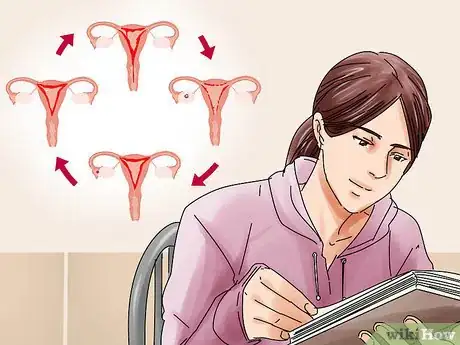
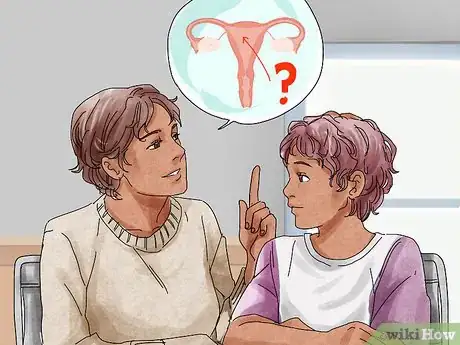

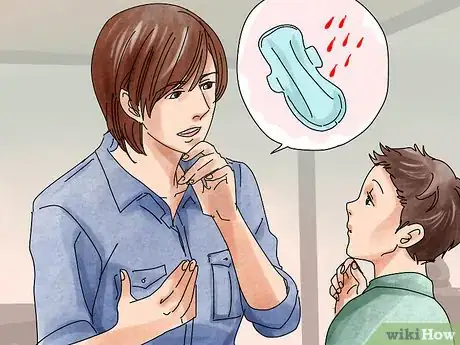
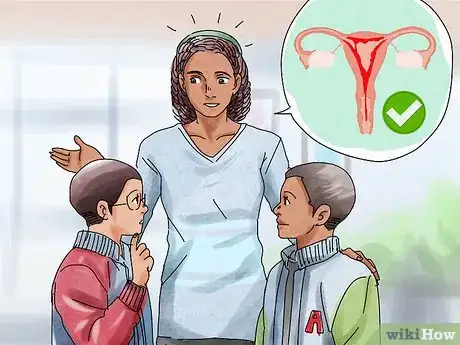

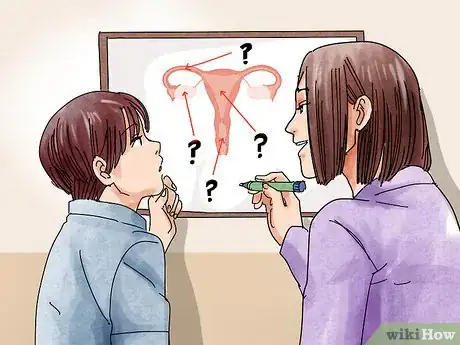
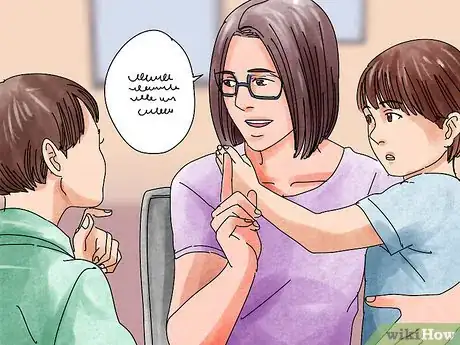
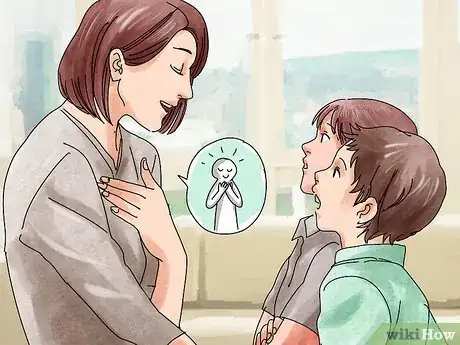




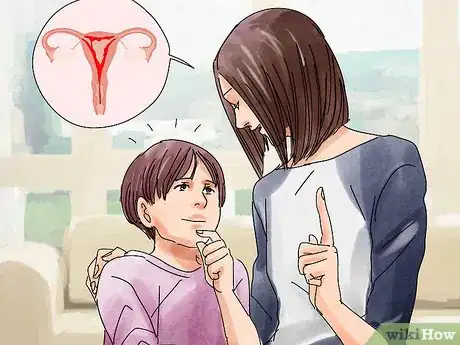




























































Medical Disclaimer
The content of this article is not intended to be a substitute for professional medical advice, examination, diagnosis, or treatment. You should always contact your doctor or other qualified healthcare professional before starting, changing, or stopping any kind of health treatment.
Read More...